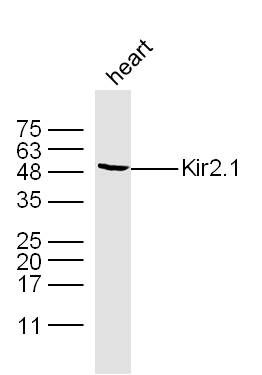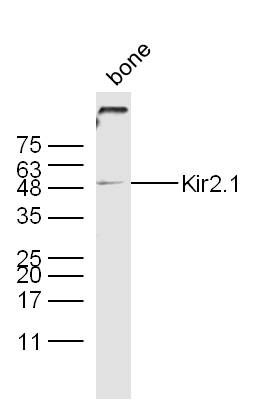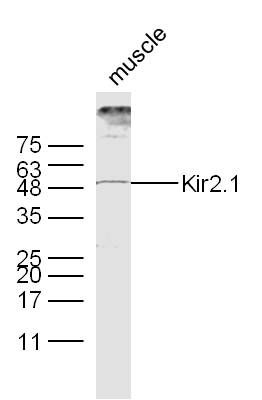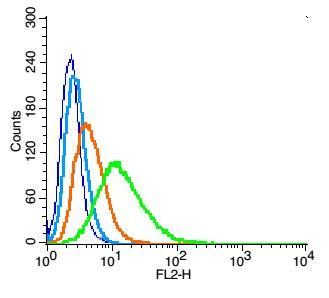产品中心
当前位置:首页>产品中心Anti-Kir2.1
货号: bs-17067R 基本售价: 1380.0 元 规格: 100ul
- 规格:100ul
- 价格:1380.00元
- 规格:200ul
- 价格:2200.00元
产品信息
- 产品编号
- bs-17067R
- 英文名称
- Kir2.1
- 中文名称
- 钾离子通道Kir2.1抗体
- 别 名
- Cardiac inward rectifier potassium channel; HHBIRK 1; HHBIRK1; HHIRK1; HIRK 1; hIRK1; Inward rectifier K; inwardly rectifying subfamily J member 2; IRK 1; IRK2_HUMAN; IRK1; KCNJ2; KIR2.1; LQT7; Potassium channel; Potassium channel inwardly rectifying subfamily J member 2; Potassium inwardly rectifying channel J2; Potassium inwardly rectifying channel subfamily J member 2; SQT 3; SQT3.

- Specific References (1) | bs-17067R has been referenced in 1 publications.[IF=5.90] Zhao, Jing, et al. "Chronic obstructive sleep apnea causes atrial remodeling in canines: mechanisms and implications." Basic Research in Cardiology 109.5 (2014): 1-13. WB ; Dog.PubMed:25015734
- 规格价格
- 100ul/1380元购买 200ul/2200元购买 大包装/询价
- 说 明 书
- 100ul 200ul
- 研究领域
- 细胞生物 神经生物学 通道蛋白
- 抗体来源
- Rabbit
- 克隆类型
- Polyclonal
- 交叉反应
- Human, Mouse, Rat, Chicken, Dog, Pig, Cow, Horse, Rabbit, Sheep,
- 产品应用
- WB=1:500-2000 ELISA=1:500-1000 IHC-F=1:400-800 Flow-Cyt=1μg/Test ICC=1:100-500 IF=1:100-500 (石蜡切片需做抗原修复)
not yet tested in other applications.
optimal dilutions/concentrations should be determined by the end user.
- 分 子 量
- 48kDa
- 细胞定位
- 细胞膜
- 性 状
- Lyophilized or Liquid
- 浓 度
- 1mg/ml
- 免 疫 原
- KLH conjugated synthetic peptide derived from human Kir2.1:31-130/427
- 亚 型
- IgG
- 纯化方法
- affinity purified by Protein A
- 储 存 液
- 0.01M TBS(pH7.4) with 1% BSA, 0.03% Proclin300 and 50% Glycerol.
- 保存条件
- Store at -20 °C for one year. Avoid repeated freeze/thaw cycles. The lyophilized antibody is stable at room temperature for at least one month and for greater than a year when kept at -20°C. When reconstituted in sterile pH 7.4 0.01M PBS or diluent of antibody the antibody is stable for at least two weeks at 2-4 °C.
- PubMed
- PubMed
- 产品介绍
- background:
Potassium channels are present in most mammalian cells, where they participate in a wide range of physiologic responses. The protein encoded by this gene is an integral membrane protein and inward-rectifier type potassium channel. The encoded protein, which has a greater tendency to allow potassium to flow into a cell rather than out of a cell, probably participates in establishing action potential waveform and excitability of neuronal and muscle tissues. Mutations in this gene have been associated with Andersen syndrome, which is characterized by periodic paralysis, cardiac arrhythmias, and dysmorphic features. [provided by RefSeq, Jul 2008]
Function:
Probably participates in establishing action potential waveform and excitability of neuronal and muscle tissues. Inward rectifier potassium channels are characterized by a greater tendency to allow potassium to flow into the cell rather than out of it. Their voltage dependence is regulated by the concentration of extracellular potassium; as external potassium is raised, the voltage range of the channel opening shifts to more positive voltages. The inward rectification is mainly due to the blockage of outward current by internal magnesium. Can be blocked by extracellular barium or cesium.
Subcellular Location:
Membrane.
Tissue Specificity:
Heart, brain, placenta, lung, skeletal muscle, and kidney. Diffusely distributed throughout the brain.
DISEASE:
Defects in KCNJ2 are the cause of long QT syndrome type 7 (LQT7) [MIM:170390]; also called Andersen syndrome or Andersen cardiodysrhythmic periodic paralysis. Long QT syndromes are heart disorders characterized by a prolonged QT interval on the ECG and polymorphic ventricular arrhythmias. They cause syncope and sudden death in response to excercise or emotional stress. LQT7 manifests itself as a clinical triad consisting of potassium-sensitive periodic paralysis, ventricular ectopy and dysmorphic features.
Defects in KCNJ2 are the cause of short QT syndrome type 3 (SQT3) [MIM:609622]. Short QT syndromes are heart disorders characterized by idiopathic persistently and uniformly short QT interval on ECG in the absence of structural heart disease in affected individuals. They cause syncope and sudden death. SQT3 has a unique ECG phenotype characterized by asymmetrical T waves.
Similarity:
Belongs to the inward rectifier-type potassium channel (TC 1.A.2.1) family.
KCNJ2 subfamily.
SWISS:
P63252
Gene ID:
3759
Database links:Entrez Gene: 3759Human
Entrez Gene: 16518Mouse
Entrez Gene: 29712Rat
Omim: 600681Human
SwissProt: P63252Human
SwissProt: P35561Mouse
SwissProt: Q64273Rat
Unigene: 1547Human
Unigene: 4951Mouse
Unigene: 44415Rat
Important Note:
This product as supplied is intended for research use only, not for use in human, therapeutic or diagnostic applications.
- 产品图片
 Sample: heart (Mouse) Lysate at 40 ug
Sample: heart (Mouse) Lysate at 40 ug
Primary: Anti-Kir2.1(bs-17067R) at 1/300 dilution
Secondary: IRDye800CW Goat Anti-Rabbit IgG at 1/20000 dilution
Predicted band size: 48 kD
Observed band size: 48 kD Sample:
Sample:
Bone (Mouse) Lysate at 40 ug
Primary: Anti-Kir2.1 (Bs- 17067R) at 1/300 dilution
Secondary: IRDye800CW Goat Anti-Rabbit IgG at 1/20000 dilution
Predicted band size: 48 kD
Observed band size: 48 kD Sample:
Sample:
Muscle (Mouse) Lysate at 40 ug
Primary: Anti-Kir2.1 (Bs- 17067R) at 1/300 dilution
Secondary: IRDye800CW Goat Anti-Rabbit IgG at 1/20000 dilution
Predicted band size: 48 kD
Observed band size: 48 kD Blank control(blue): RSC96(fixed with 2% paraformaldehyde (10 min)).
Blank control(blue): RSC96(fixed with 2% paraformaldehyde (10 min)).
Primary Antibody:Rabbit Anti- Kir2.1 antibody(bs-17067R), Dilution: 0.2μg in 100 μL 1X PBS containing 0.5% BSA;
Isotype Control Antibody: Rabbit IgG(orange) ,used under the same conditions );
Secondary Antibody: Goat anti-rabbit IgG-PE(white blue), Dilution: 1:200 in 1 X PBS containing 0.5% BSA.

